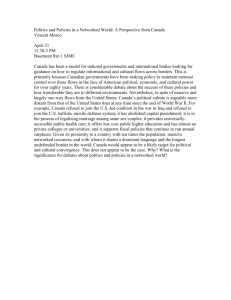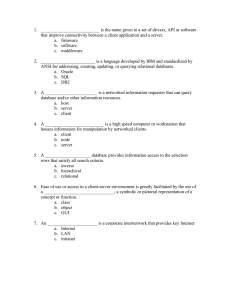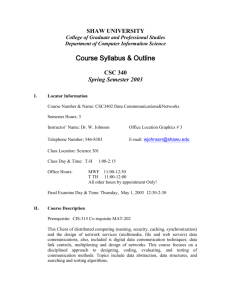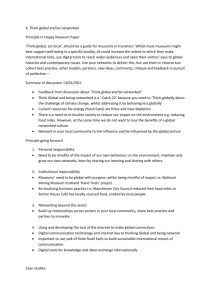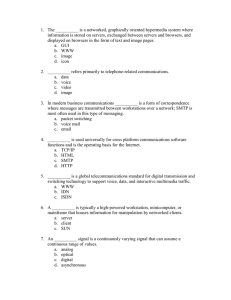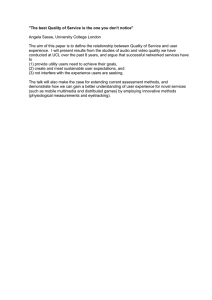Chapter 11 by David G. Messerschmitt Understanding Networked Applications:
advertisement
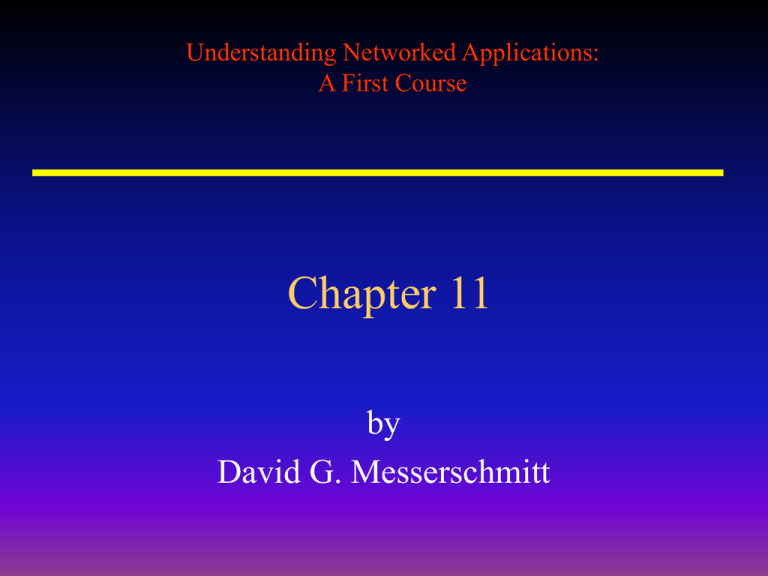
Understanding Networked Applications: A First Course Chapter 11 by David G. Messerschmitt Understanding Networked Applications: A First Course Algorithms and protocols by David G. Messerschmitt Algorithm • Specified sequence of steps that – accomplish a designated task – in a finite number of steps • Representation: – simple algorithm: flowchart – complicated algorithm: program Understanding Networked Applications 3 A First Course Example: one turn at monopoly Start turn Move token number of squares indicated on dice Throw dice Move to “jail” square Yes Land on “go to jail”? No Finish turn Understanding Networked Applications Do not move; follow policies for square (like “pay rent”) 4 A First Course Algorithm building blocks Start Start Start Programming languages support these three building blocks Action Decision Action Action Test Action Action Action Finish Sequence Finish Finish Selection Loop Understanding Networked Applications 5 A First Course Protocol • Distributed algorithm realized by two or more modules to coordinate their actions or accomplish some shared task • Module interoperability requires a protocol – Prescribed order of method invocations – Part of interface documentation Understanding Networked Applications 6 A First Course Monopoly players protocol Player 1 Player 2 One-turn algorithm This is a protocol interaction diagram Understanding Networked Applications Time 7 A First Course Application and infrastructure The application defines its own application-level protocols Internally, the network uses protocols to implement the services it provides Understanding Networked Applications 8 A First Course Three simple protocols • One-way message: send-receive • Two-way interaction: request-response • Push: publish-subscribe Understanding Networked Applications 9 A First Course Client Server send receive request response subscribe responses Time Understanding Networked Applications 10 A First Course Example: HTTP User activates URL HTTP request HTTP client (browser) Browser displays document (if HTML) or invokes “helper application” HTTP server HTTP response (embedded document) Understanding Networked Applications HTML documents 11 A First Course Example: Stock trading Customer Customer wants to purchase 10 shares of MSFT if price is below $90 StockTrader What is application protocol? Understanding Networked Applications 12 A First Course Understanding Networked Applications: A First Course Locating things by David G. Messerschmitt Three ways of locating things • Name – “Joe Bloe” • Address – “1299 Hearst St, Berkeley, CA” • Reference – “Postmaster of Berkeley CA” Understanding Networked Applications 14 A First Course Name • Symbolic (character string) representation • Easy for people to remember or guess • Identifies but does not locate directly – Distinction important for mobile entities • Not unique: entities can have more than one name (called aliases) Understanding Networked Applications 15 A First Course Hierarchical names • Hierarchy makes names easier to remember or guess • Host domain names: – “info.sims.berkeley.edu” – designates administrative hierarchy • File names: – “c:\My Documents\Docs\Resume.doc” – designates folder hierarchy Understanding Networked Applications 16 A First Course Address • Route or path to entity – is directly specified, or – can be inferred • Independent of who or what is locating entity • Topological specification Understanding Networked Applications 17 A First Course Example 4 3 1 2 Path from to is (1,2,2,2,1,1,1,1) Not an address, because it depends on starting point Understanding Networked Applications 18 A First Course Example (1,1) (1,2) (1,3) (1,4) (1,4) (2,1) (2,2) (2,3) (2,4) (2,5) Address of is (2,5) Route from can be inferred Understanding Networked Applications 19 A First Course Reference • Abstract representation of an entity • Interaction is with representation – infrastructure arranges redirection to actual entity – especially appropriate for things that move Understanding Networked Applications 20 A First Course Reference Client Server address Understanding Networked Applications 21 A First Course Name services 3. interaction 1. name 2. address or reference Name service Understanding Networked Applications 22 A First Course
